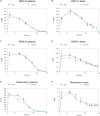The Experimental Oxime K027-A Promising Protector From Organophosphate Pesticide Poisoning. A Review Comparing K027, K048, Pralidoxime, and Obidoxime
- PMID: 31191210
- PMCID: PMC6547910
- DOI: 10.3389/fnins.2019.00427
The Experimental Oxime K027-A Promising Protector From Organophosphate Pesticide Poisoning. A Review Comparing K027, K048, Pralidoxime, and Obidoxime
Abstract
Poisoning with organophosphorus compounds (OPCs) is a major problem worldwide. Standard therapy with atropine and established oxime-type enzyme reactivators (pralidoxime, obidoxime) is unsatisfactory. In search of more efficacious broad-spectrum oximes, new bispyridinium (K-) oximes have been synthesized, with K027 being among the most promising. This review summarizes pharmacokinetic characteristics of K027, its toxicity and in vivo efficacy to protect from OPC toxicity and compares this oxime with another experimental bisquaternary asymmetric pyridinium aldoxime (K048) and two established oximes (pralidoxime, obidoxime). After intramuscular (i.m.) injection, K027 reaches maximum plasma concentration within ∼30 min; only ∼2% enter the brain. Its intrinsic cholinesterase inhibitory activity is low, making it relatively non-toxic. In vitro reactivation potency is high for ethyl-paraoxon-, methyl-paraoxon-, dichlorvos-, diisopropylfluorophosphate (DFP)- and tabun-inhibited cholinesterase. When administered in vivo after exposure to the same OPCs, K027 is comparable or more efficacious than pralidoxime and obidoxime. When given as a pretreatment before exposure to ethyl-paraoxon, methyl-paraoxon, DFP, or azinphos-methyl, it is superior to the Food and Drug Administration-approved compound pyridostigmine and comparable to physostigmine, which because of its entry into the brain may cause unwanted behavioral effects. Because of its low toxicity, K027 can be given in high dosages, making it a very efficacious oxime not only for postexposure treatment but also for prophylactic administration, especially when brain penetration is undesirable.
Keywords: Cox analysis; carbamates; cholinesterase; obidoxime; paraoxon; pralidoxime; prophylaxis; pyridostigmine.
Figures


Similar articles
-
Experimental and Established Oximes as Pretreatment before Acute Exposure to Azinphos-Methyl.Int J Mol Sci. 2021 Mar 17;22(6):3072. doi: 10.3390/ijms22063072. Int J Mol Sci. 2021. PMID: 33802843 Free PMC article.
-
Therapeutic and reactivating efficacy of oximes K027 and K203 against a direct acetylcholinesterase inhibitor.Neurotoxicology. 2016 Jul;55:33-39. doi: 10.1016/j.neuro.2016.05.006. Epub 2016 May 10. Neurotoxicology. 2016. PMID: 27177985
-
Reversible cholinesterase inhibitors as pretreatment for exposure to organophosphates. A review.J Appl Toxicol. 2019 Jan;39(1):101-116. doi: 10.1002/jat.3662. Epub 2018 Jul 19. J Appl Toxicol. 2019. PMID: 30027640 Review.
-
Efficacy of eight experimental bispyridinium oximes against paraoxon-induced mortality: comparison with the conventional oximes pralidoxime and obidoxime.Neurotox Res. 2009 Jul;16(1):60-7. doi: 10.1007/s12640-009-9048-7. Epub 2009 Apr 7. Neurotox Res. 2009. PMID: 19526299
-
Pyridinium oxime reactivators of cholinesterase inhibited by diisopropyl-fluorophosphate (DFP): predictive value of in-vitro testing for in-vivo efficacy.Mini Rev Med Chem. 2008 Nov;8(13):1328-42. doi: 10.2174/138955708786369555. Mini Rev Med Chem. 2008. PMID: 18991751 Review.
Cited by
-
Development of a CNS-permeable reactivator for nerve agent exposure: an iterative, multi-disciplinary approach.Sci Rep. 2021 Jul 30;11(1):15567. doi: 10.1038/s41598-021-94963-2. Sci Rep. 2021. PMID: 34330964 Free PMC article.
-
Recent developments on oximes to improve the blood brain barrier penetration for the treatment of organophosphorus poisoning: a review.RSC Adv. 2020 Jan 27;10(8):4465-4489. doi: 10.1039/c9ra08599h. eCollection 2020 Jan 24. RSC Adv. 2020. PMID: 35495228 Free PMC article. Review.
-
Pharmacokinetics of three novel pyridinium aldoxime acetylcholinesterase reactivators in female rats.Toxicol Appl Pharmacol. 2022 Jul 1;446:116046. doi: 10.1016/j.taap.2022.116046. Epub 2022 May 10. Toxicol Appl Pharmacol. 2022. PMID: 35550885 Free PMC article.
-
Understanding the Interaction Modes and Reactivity of Trimedoxime toward MmAChE Inhibited by Nerve Agents: Theoretical and Experimental Aspects.Int J Mol Sci. 2020 Sep 5;21(18):6510. doi: 10.3390/ijms21186510. Int J Mol Sci. 2020. PMID: 32899591 Free PMC article.
-
In Vitro Evaluation of Oxidative Stress Induced by Oxime Reactivators of Acetylcholinesterase in HepG2 Cells.Chem Res Toxicol. 2023 Dec 18;36(12):1912-1920. doi: 10.1021/acs.chemrestox.3c00203. Epub 2023 Nov 11. Chem Res Toxicol. 2023. PMID: 37950699 Free PMC article.
References
-
- Antonijevic E., Musilek K., Kuca K., Djukic-Cosic D., Curcic M., Miladinovic D. C., et al. (2018b). Dose-response modeling of reactivating potency of oximes K027 and K203 against a direct acetylcholinesterase inhibitor in rat erythrocytes. Food Chem. Toxicol. 121 224–230. 10.1016/j.fct.2018.08.065 - DOI - PubMed
-
- Balali-Mood M., Balali-Mood K. (2008). Neurotoxic disorders of organophosphorus compounds and their managements. Arch. Iran. Med. 11 65–89. - PubMed
Publication types
LinkOut - more resources
Full Text Sources

